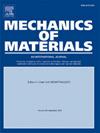Higher-order indentation model based on mixture unified gradient with surface elasticity: A theoretical study
IF 3.4
3区 材料科学
Q2 MATERIALS SCIENCE, MULTIDISCIPLINARY
引用次数: 0
Abstract
This study proposes a higher-order framework for half-space indentation based on mixture unified gradient theory (MUGT) with surface elasticity (SE). MUGT, a well-posed theory that captures both nonlocal and strain gradient properties, is essential for understanding size effects in nano/micro-scale materials and structures. However, indentation problems considering MUGT remain unexplored. We develop efficient analytical and numerical methods to address the problem. In the 3D context, the stress components are analytically determined using 2D Fourier transform applied to constitutive relations that incorporate stress gradient elasticity. Regarding the contact pressure, the problem results in integral equations whose kernel is challenging to obtain explicitly. These are numerically solved using the sum of independent functions, rather than relying on discrete point values as done in previous studies on singular integral equations. Our findings demonstrate that stress gradient elasticity leads to greater surface vertical displacement, whereas strain gradient and surface elasticity result in smaller surface vertical displacement, highlighting the softening and hardening behaviors respectively. Drastically different contact pressure distributions and surface vertical displacements can be obtained compared to existing theories. Particularly, both hardening and softening of size-dependent indentation hardness are intrinsically captured, aligning with available experimental observations. These behaviors, however, are challenging to simultaneously reflect in existing indentation theories due to the exclusion of stress gradient elasticity. The study enhances the understanding of contact mechanics and is of practically significance for nano/micro-scale materials and structures.
基于混合统一梯度和表面弹性的高阶压痕模型的理论研究
提出了一种基于混合统一梯度理论(MUGT)和表面弹性(SE)的半空间压痕高阶框架。MUGT是一种完备的理论,可以捕获非局部和应变梯度特性,对于理解纳米/微尺度材料和结构中的尺寸效应至关重要。然而,考虑到MUGT的缩进问题仍未被探索。我们开发了有效的分析和数值方法来解决这个问题。在3D环境中,应力分量是使用应用于包含应力梯度弹性的本构关系的二维傅里叶变换来解析确定的。对于接触压力,问题的结果是积分方程,其核很难明确地得到。这些都是用独立函数的和进行数值求解,而不是像以前研究奇异积分方程那样依赖于离散点值。研究结果表明,应力梯度弹性导致较大的表面垂直位移,而应变梯度和表面弹性导致较小的表面垂直位移,分别表现出软化和硬化行为。与现有理论相比,可以得到截然不同的接触压力分布和表面垂直位移。特别是,与尺寸相关的压痕硬度的硬化和软化本质上被捕获,与现有的实验观察一致。然而,由于排除了应力梯度弹性,现有压痕理论很难同时反映这些行为。该研究增强了对接触力学的认识,对纳米/微尺度的材料和结构具有实际意义。
本文章由计算机程序翻译,如有差异,请以英文原文为准。
求助全文
约1分钟内获得全文
求助全文
来源期刊

Mechanics of Materials
工程技术-材料科学:综合
CiteScore
7.60
自引率
5.10%
发文量
243
审稿时长
46 days
期刊介绍:
Mechanics of Materials is a forum for original scientific research on the flow, fracture, and general constitutive behavior of geophysical, geotechnical and technological materials, with balanced coverage of advanced technological and natural materials, with balanced coverage of theoretical, experimental, and field investigations. Of special concern are macroscopic predictions based on microscopic models, identification of microscopic structures from limited overall macroscopic data, experimental and field results that lead to fundamental understanding of the behavior of materials, and coordinated experimental and analytical investigations that culminate in theories with predictive quality.
 求助内容:
求助内容: 应助结果提醒方式:
应助结果提醒方式:


